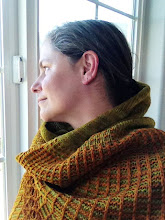Tutorial: Russian Join
I hate weaving in ends. Hate. It. Working with (non superwash) wool is great because I can spit splice. But what about non feltable fibers? Today I am spreading the gospel of the Russian join! Perfect for silk, cotton and superwash.
Here we have an undone knot in my skein. I am about to join it with the Russian join.

Thread your yarn through a tapestry needle. (I use a sewing needle for laceweight, because it is small and sharp). This is a dk weight, though, so a larger needle works perfectly. You will be weaving the needle through the yarn about 2-3 inches after creating a loop at the end.

Pull the needle through, leaving the yarn bunched up and the loop open.

Fan out the fiber at the end.

Trim the fiber into a wedge shape to avoid lumps down the road when you pull the yarn tight.

Repeat with the yarn you are joining, being sure to interlock the loops.

Begin closing the loops and pulling the yarn smooth. The wedges on the ends will be hidden inside the yarn.

Keep closing the loops, smoothing out the join and working the yarn into place.

Almost smooth.

Done!

Now try to pull it apart. It holds beautifully, even on silk! It will be a bit thicker at the joining point, but you won't notice it when the yarn is knit up. I love using this join on kidsilk haze, too. :)
Here we have an undone knot in my skein. I am about to join it with the Russian join.

Thread your yarn through a tapestry needle. (I use a sewing needle for laceweight, because it is small and sharp). This is a dk weight, though, so a larger needle works perfectly. You will be weaving the needle through the yarn about 2-3 inches after creating a loop at the end.

Pull the needle through, leaving the yarn bunched up and the loop open.

Fan out the fiber at the end.

Trim the fiber into a wedge shape to avoid lumps down the road when you pull the yarn tight.

Repeat with the yarn you are joining, being sure to interlock the loops.

Begin closing the loops and pulling the yarn smooth. The wedges on the ends will be hidden inside the yarn.

Keep closing the loops, smoothing out the join and working the yarn into place.

Almost smooth.

Done!

Now try to pull it apart. It holds beautifully, even on silk! It will be a bit thicker at the joining point, but you won't notice it when the yarn is knit up. I love using this join on kidsilk haze, too. :)
Labels: tutorials







20 Comments:
I tried this technique once but didn't have great results. I think your tutorial will help and the timing is just right since I'm knitting a pair of socks in superwash and I know there are a couple of knots in this skein. Thanks!
If there weren't Russian joins, I would never finish anything. Love them and it's good to know they work on other fibres.
thanks for sharing! i'll have to try this on my next project!
That's awesome, thanks Rosemary!
Thank you for that. I have tried this unsuccessfully from a verbal instruction. Your pictures make it so much clearer.
Thanks for the tutorial on your method of Russian splicing -- it is a little different than the one I have used and looks like it could come in handy!
Great, I have used a needle to run through the new yarn to connect it but this is much better because it will not come apart when tugged on.
Thank you for the tutorial
Oh wow- that is brilliant. I am going to have to print that out so that I have it when I need it!! Thanks for sharing!
Very cool!! I hate weaving in ends too. Thanks!
Hi Romi,
I wanted to send you an email but the direct contact link doesn't work on my system and I couldn't find your mail-adress, so I write here at the comments. The shawl - pins I ordered arrived today, they are very beautiful - thank you! And I was surprised to see, you are speking German?!? - Danke! ;-)
Alexandra
I've used the Russian join on lace and spit splicing on heavier wool. I find that they work best in slightly fuzzy or textured yarns. I've been very disappointed when working in smooth yarns.
That is beautiful! I can't wait to try that.
The Russian join ranks right up there with circular knitting & sliced bread! What did I ever do w/o it? I know...wove in more ends that I care to think. I agree w Yarnhog, I've had better sucess with heavier yarns, but maybe I'm doing something I shouldn't or not doing something I should. I haven't tried fanning; maybe that will help.
Rosemary- Looks too much like "work" to me!
I will give it a try.
That you so much for this! I've always been confused by the description of the Russian join, but I think I've got it now...
I love it, and have used it a lot since I knitted my first Ice Queen. Thanks for the tut :)
thank you; i've never seen this done up close; it's a great technique
I've been planning to use a sewn splice for my slippery joins after having a blocking disaster with my Ravelympics shawl (plied splice, baby alpaca...always worked before..not this time accck!). This looks even more refined...anotehr perfect solution. Thanks!
Finally had a chance to try it. Works wonderfully! Thanks for posting!
Fantastic! Thanks for posting this with such clear instructions and photos. I just tried the technique and am pleased with the result.
Post a Comment
<< Home